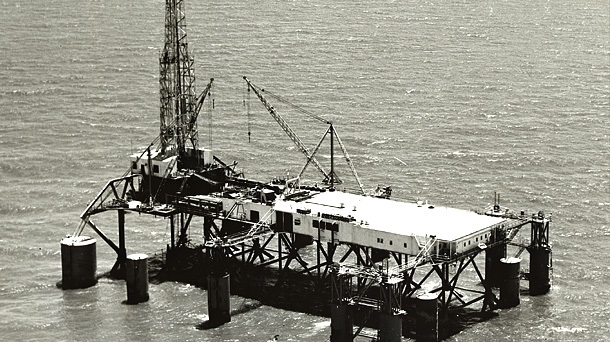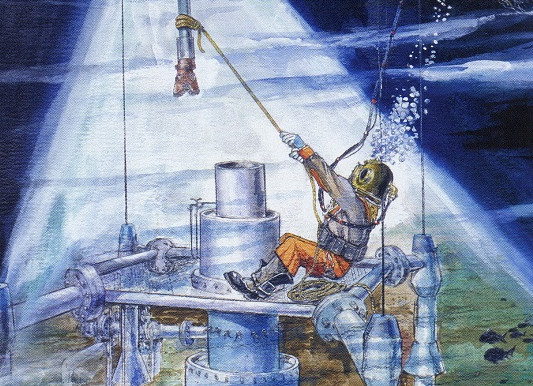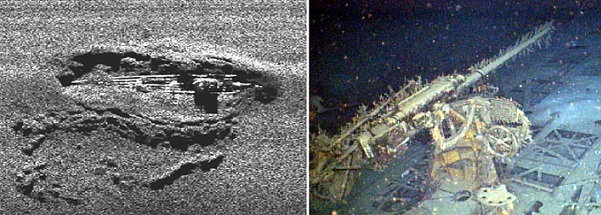Technologies for petroleum exploration and production from lakes, piers and out of sight of land.
According to Mercer County historians in Ohio, America’s offshore oil and natural gas industry began in the late 1880s when high water surrounded rigs at Grand Lake St. Marys. Many Californian historians note the oil wells drilled from piers beginning in 1896 at Summerland in Santa Barbara County.

Launched in 1954 and capable of drilling wells in water up to 40 feet in depth, Mr. Charlie was the world’s first mobile offshore drilling platform. It was designated a National Historic Landmark in December 2024. Photo courtesy Murphy Oil.
After World War II in the Gulf of Mexico, an advanced Kerr-McGee drilling platform — the Kermac Rig No. 16 — became the first offshore rig that was out of sight of land. By 1950, the Gulf’s new offshore petroleum industry had discovered 11 oil and natural gas fields. Launched in 1954, the converted barge Mr. Charlie was the first rig designed for moving to new locations.
Mr. Charlie, First Mobile Offshore Drilling Rig
When Mr. Charlie left its New Orleans shipyard for the Gulf of Mexico on June 15, 1954, it became the world’s first mobile offshore drilling unit (MODU). Using advanced technology, the self-sufficient rig drilled in a new oilfield near the mouth of the Mississippi River. A reporter noted the new “singularly monstrous contraption” could drill “a 12,000-foot hole at a different location every month.”
Today the International Petroleum Museum and Exposition in Morgan City, Louisiana, in December 2024 the Department of the Interior designated the world’s first mobile offshore platform as a National Historic Landmark. The American Society of Mechanical Engineers named the rig a Historic Mechanical Engineering Landmark in 2012.
THUMS – California’s Hidden Oil Islands
California’s 1921 oil discovery at Signal Hill launched a drilling boom that would extend westward as competitors chased any sign of oil to the Pacific Ocean. In 1962, City of Long Beach voters approved “controlled exploration and exploitation of the oil and gas reserves” underlying their harbor, leading to creation of four man-made islands that blended in with the coastal environment. The artfully disguised islands today operate more than 1,000 oil wells in one of the most innovative oilfield designs in the world.
Oil Seeps and Santa Barbara Oil Spill
Natural seeps leak thousands of tons of petroleum a day – and have for several hundred thousand years. The Environmental Protected Agency was established a year after a Union Oil Company drilling platform in 1969 suffered a blowout six miles off Santa Barbara. Exhibits at the Santa Barbara Maritime Museum explain the continuing process of oil emerging from natural seeps in the channel – and visited by tourists in boats.

Detail from “Stabbing in,” a 2007 offshore roughneck painting by Clyde Olcott. The hazardous job was replaced by technologies like remotely operated vehicles.
Deep Sea Roughnecks
The complexity of offshore exploration and production has led to many new technologies. In 1948, Shell Oil Company and others pioneered the use of underwater television cameras for survey, inspection, and repair work. The Navy also developed deep-sea technologies for submarine rescue. Despite state-of-the-art robotics, the offshore industry and scientists continue to need skilled, deep-sea divers.
Offshore Drilling Exploration History
In 1894, Henry Williams drilled two wells on a California beach. He drilled another in 1895 with encouraging results. This led Williams and others to explore for oil offshore the next year. In 1911, Gulf Refining Company abandoned the use of piers. It drilled Ferry Lake No. 1 on Caddo Lake, Louisiana, using a fleet of tugboats, barges, and floating pile drivers. Today, more than 5,000 offshore oil and natural gas platforms operate in the Gulf of Mexico around the clock.
Offshore Rig Patent
The modern offshore petroleum industry can trace its roots to an 1869 offshore rig patent by New York engineer Thomas Rowland, who had helped build the USS Monitor during the Civil War. On May 4, 1869, Thomas Fitch Rowland, owner of Continental Iron Works in Greenpoint, New York, received a patent for his “submarine drilling apparatus.”
Ohio Offshore Wells
Completed in 1845, Grand Lake St. Marys in Ohio was the largest man-made body of water in the world at 17,500 acres with a depth of about seven feet. Dug by hand, it served as a feeder reservoir supporting commerce on the Miami and Erie canals. By 1887, Mercer County records show oil production from wells pumping on platforms on the lake.
Oil Piers, Platforms, and Barges
A circa 1920 view of oil piers at Santa Barbara, California, beaches; a historical marker at Caddo Lake, Louisiana, erroneously claims oil wells drilled in 1911 were “the world’s first over water.” Searching for new reserves, Kerr-McGee Oil Industries pioneered offshore drilling in the Gulf of Mexico and proved the feasibility of tender-serviced oil platforms at sea

A 2001 archaeological survey by BP and Shell prior to construction of a natural gas pipeline confirmed the discovery of U-166 about 45 miles off the Louisiana coast.
Petroleum Survey discovers U-Boat
Petroleum companies operating in the Gulf of Mexico’s outer continental shelf routinely provide the government with sonar data for areas with potential archaeological value. A 2001 archaeological survey by BP and Shell prior to construction of a natural gas pipeline confirmed discovery of the World War II German submarine U-166 about 45 miles off the Louisiana coast.
Rigs to Reefs
A federal program benefits the U.S. economy and the environment by using offshore petroleum platforms to create artificial reefs for ideal marine habitats. Beginning with an Exxon experimental subsea structure in 1979, the “Rigs to Reefs” program has formed the world’s largest artificial reef habitat in the world.
ROV – Swimming Socket Wrench
Much of today’s offshore oil and natural gas industry relies on remotely operated vehicles that can trace their roots back to Howard Hughes, Jr. In 1960, Shell Oil and Hughes Aircraft began modifying a landlocked “Manipulator Operated Robot” – known as MOBOT – into one that could operate underwater. The result led to the ROV (Remotely Operated Vehicle), which revolutionized offshore petroleum exploration and production.
More Offshore Resources
For educators, students, and researchers, recommended books and a reading list (with links to Amazon books) adapted from the American Oil & Gas Historical Society’s “This Week in Petroleum History.” Included is the 2019 book Breaking the Gas Ceiling: Women in the Offshore Oil and Gas Industry, which offers personal accounts from offshore pioneers — see Women of the Offshore Petroleum Industry tell Their Stories.
For offshore history books, many professional societies and associations (see national and state contacts) offer recommendations. AOGHS provides links to other resources related to petroleum history.
———————————————
The American Oil & Gas Historical Society (AOGHS) preserves U.S. petroleum history. Please become an AOGHS annual supporter and help maintain this energy education website and expand historical research. For more information, contact bawells@aoghs.org. © 2025 Bruce A. Wells.


